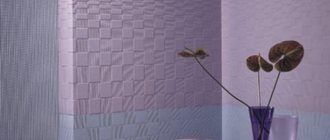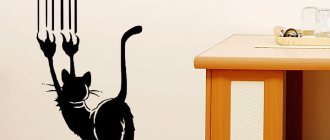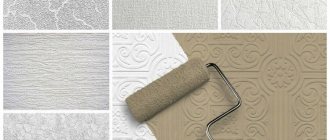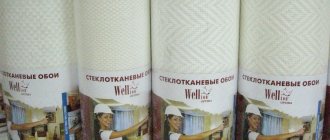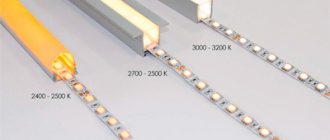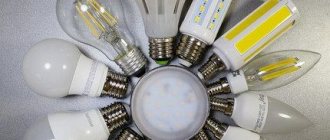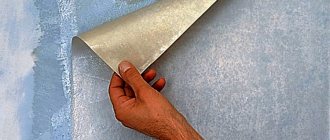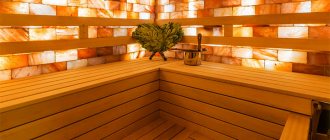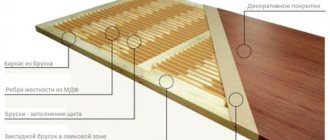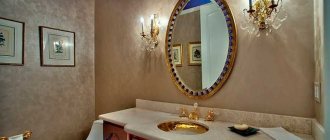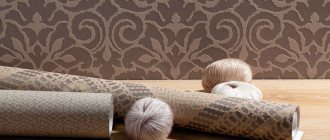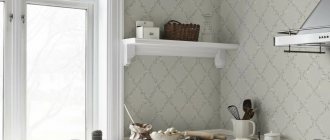Many years ago, during the times of the Soviet Union, construction experts advised using paper or ordinary newspaper sheets as the first layer before gluing trellises. Such a backing for wallpaper improved adhesion to the wall and slightly increased the temperature of the walls, which was especially noticeable in the cold season.
Today, the range of substrates has increased significantly. And their main task was heat and sound insulation. This is especially true in new buildings with thin walls. The second is to hide uneven walls or even stains on them. This way, contaminants will not appear on wall surfaces. It is also important that any type of substrate will protect against the formation of fungus and mold; it consists of two layers of paper, between which there is another material. Let's consider its main types.
Paintable wallpaper: advantages
Wallpaper for painting is chosen by practical people who were able to appreciate all the many advantages of this type of finishing:
- the ability to repaint the surface of the wallpaper, thereby quickly updating the interior without unnecessary hassles such as removing the coating, preparing the walls, etc. It is enough to choose a suitable shade of paint;
- sufficient variety . Wallpaper for painting is usually produced in white, milky, or beige shades; wallpaper in bright colors is less common. The surface can be either smooth or embossed , the pattern can be absolutely anything, from imitation plaster to floral patterns;
- the ability to paint the wallpaper in absolutely any shade you want;
- dense material can hide small unevenness in the walls .
Determining the top of the roll
When wallpapering, you need to choose the right top of the wallpaper. In each roll, the top, also known as the starting end, is located on the outside. All manufacturers strive to do just this for convenience, so that during work there is no need to unwind the entire roll.
When starting work, the top of the roll is applied to the ceiling and the required length begins to be measured.
Paintable wallpaper: cons
This type of finish also has disadvantages:
- the number of new layers of paint is limited , ranging from approximately 4 to 15. The number can be indirectly judged by the depth of the relief. If you repaint the wallpaper too often, you can lose the texture;
- some types can hardly be called budget;
- When painting some wallpaper, difficulties may arise, so you will have to call a specialist, but in most cases you can do it yourself.
These are all general characteristics; specific properties will depend on the material from which the wallpaper is made.
A couple of tips on applying paint and varnish material
- Be sure to wait until the wallpaper glue has completely dried.
- Carefully monitor the presence of bubbles formed under the finish and remove them in a timely manner.
- Seal areas that cannot be painted in advance with masking tape.
- Using different pressure on the roller, you can paint the sunken and convex parts of the ornament in different shades.
- Fill particularly deep parts of the pattern and hard-to-reach places with a brush.
Painting wallpaper using a roller
Types of wallpaper for painting
There are several types of paintable wallpaper, depending on the base. Basically, these are paper, non-woven wallpaper and glass wallpaper. Now more about each of them.
Paper wallpaper for painting
Paper wallpaper, as a rule, consists of two or three layers of paper , the result is a rather dense and thick material with a certain relief pattern. Sometimes sawdust is added, which increases the density and helps create the pattern. In order for such wallpapers to be repainted several times, special water-repellent agents , which allows them to maintain their structure after several paintings. Such wallpapers are usually produced in white. Occasionally, light pastel shades may be found.
Depending on the nuances of production, the following types of paper wallpaper for painting are distinguished:
- Raufauser - two- or three-layer wallpaper with sawdust between the layers of paper. The drawing turns out simple, chaotic, but cute. Wallpaper is inexpensive and is used when it is necessary to quickly and cheaply hide the imperfections of a rough surface. When wet, such wallpaper shrinks , so glue must be applied to the canvas and wait until it is completely saturated;
- Raufauser fleece differs in that the bottom layer is impregnated with special substances, which prevents shrinkage of the fabric . The glue can be applied to the wall, which is much more convenient;
- embossed wallpaper uses a paper base, and the top layer is created from a mixture of wax, wood flour, chalk, etc. The top part of the roll is fragile, but after gluing it becomes stronger every year. It is not easy to glue such wallpaper, so it is better to call in professionals;
- Embossed wallpaper differs in the material used to make the front layer - it is cellulose paper. It does not absorb paint well, so its consumption when painting will be economical.
pros:
- They hide minor wall defects well ;
- can be used to decorate ceilings;
- sufficient variety of textures ;
- withstands up to 7 repaintings;
- the material “ breathes ”;
- low cost.
Minuses:
- low strength , fear of mechanical damage. If there are children and animals at home, it is better not to use;
- low durability , up to 5 years;
- when shrinking, buildings can tear , so it is better not to glue them in new buildings;
- When gluing, they can tear and wrinkle , so you should be extremely careful.
Non-woven wallpaper for painting
This is probably one of the most successful finishing materials in general and among wallpapers for painting in particular. They consist of two layers : non-woven fabric and vinyl coating , which models the relief.
There are smooth non-woven wallpapers without vinyl coating (the so-called “spider web”). They are used to finish perfectly smooth walls without defects. More often you can find embossed non-woven wallpaper on sale, which will hide unevenness and provide an interesting interior.
Among the advantages of non-woven wallpaper for painting :
- relative ease of gluing , since this is exactly the material that requires applying glue to the wall, and not to the wallpaper. There will be no need to prepare a lot of space for laying out the wallpaper, wait until the glue is absorbed a little - the process is simplified;
- after gluing, non-woven wallpaper shows itself to be a “tough nut to crack” - it does not swell , rarely deforms and does not shrink;
- can be produced in a white version or be colored: and if previously only the first option was common, now many manufacturers produce a huge amount of already colored non-woven wallpaper. In any case, they are great for both walls and ceilings;
- even more than paper ones, they are capable of hiding flaws . They are recommended to be used even in new buildings , since the walls there shrink, and these wallpapers will not only hide the crack, but will also be able to keep it from further spreading;
- withstand high humidity and temperature changes;
- do not contain harmful substances, do not affect health;
- Depending on the relief, they can withstand up to 10-15 repaintings.
Disadvantages of non-woven wallpaper for painting:
- vinyl coating requires high-quality painting , otherwise it can quickly become damaged;
- may stretch when glued
- are more expensive than other types of wallpaper for painting;
- They are afraid of aggressive chemicals, so it is better not to use them in the kitchen or to glue them away from the stove and work surface.
Paintable vinyl wallpaper
When they talk about vinyl wallpaper for painting, they mean canvases with a base made of paper or non-woven fabric, which are covered with a layer of vinyl on top. This fragile coating provides the material with a relief pattern, but requires mandatory protection.
The embossed and embossed paper wallpapers we mentioned earlier may have a top layer of vinyl. The result is a cheaper, but also less environmentally friendly material. We also already talked about non-woven base with vinyl coating in the section on non-woven wallpaper.
Fiberglass wallpaper for painting
Fiberglass is a special type of material that is made from a mixture of soda, sand, lime and dolomite. All this actually forms glass, from which fiberglass fibers are drawn. Fiberglass wallpaper can be two-layer , i.e. have a paper backing, or single-layer . There are fiberglass (smooth wallpaper) and fiberglass (they have a certain three-dimensional pattern).
pattern can be formed from two threads . These are herringbone, matting, diamonds, diagonals, etc. A more complex pattern is called jacquard , it is programmed on a computer . In fact, you can create absolutely any ornament.
pros:
- glass is not afraid of fire, so glass wallpaper also has a high degree of fire safety ;
- have much in common with fiberglass and “gossamer”, so there is an effect of strengthening the surface, as well as masking small cracks ;
- you can repaint up to 10-25 times , if there are more layers of paint, then there is a risk that the relief will simply be lost;
- high wear-resistant properties, they can be washed, even using a brush. All this makes it possible to use them in rooms where a large number of people pass during the day, as well as in quieter rooms;
- rolls of glass wallpaper usually exceed standard parameters , so it will be possible to reduce the number of scraps and reduce the number of joints;
- durability.
Minuses:
- during installation, special glue is used, which is more expensive than regular wallpaper;
- installation is carried out with protective glasses and gloves, as the wallpaper can crumble and damage the skin;
- if there are stains on the walls, the wallpaper may also gradually become colored;
- When dismantling, they are removed with putty.
Anti-vandal wallpaper for painting
This wallpaper is distinguished by a dense vinyl layer , which can be repainted many times. If there are animals and children at home, then this finish is a good way to solve the problem of scratches on the walls, because the material is highly wear-resistant.
The base is usually non-woven fabric (less often paper), i.e. What we have in front of us is essentially non-woven wallpaper.
Polyethylene
This, of course, is not smooth polyethylene, similar to film, but special foamed polyethylene. At its core, it is a type of polystyrene foam. The latter is often used as insulation and sound insulation on the external walls of an apartment. It is considered the highest quality material on the modern market. It is polyethylene foam roll substrates that are recommended to be used both in a country house and in new buildings.
The most famous example of this material is the wallpaper underlay Polif. It appeared on the market more than 60 years ago (in the 1960s), but interest in it still does not fade. And its characteristics with a thickness of only 5 mm. are not inferior to modern models.
Other manufacturers include:
- Wallpaper backing RESOURCE. Has several thickness options. For a relatively low price you will get good sound and heat insulation. Produced in Russia.
- Wallpaper backing Penolon. Also produced in the Russian Federation. The manufacturer states that this is primarily a leveling material. However, it does an excellent job of reducing noise and increasing the temperature of external walls.
Density, texture and other selection criteria
In addition to the material of execution, other factors should be taken into account when choosing :
- The density of the wallpaper for painting determines how well the material can hide the unevenness of the walls. there are small flaws on the surface , then it is better to take wallpaper with a density of about 130 g/m2 or a little more , but you should not chase the highest density values, since you may encounter difficulties during installation and painting;
- texture of wallpaper for painting . If the walls have small defects, then it makes sense to take wallpaper with a pronounced texture. Smooth wallpaper requires an almost perfect surface. Remember that if there is a pattern on the canvas, it will need to be joined, which means the material consumption will increase;
- where is the glue applied? When gluing glass and non-woven wallpaper, the glue is applied to the wall - this makes the work much easier. Some types of paper wallpaper require the application of glue to the canvas, which complicates the installation process;
- care . There are wallpapers that can withstand wet cleaning and even brushing. They are indispensable in the kitchen and hallway. There are finishes that can only be dry cleaned. Consider the operating features when purchasing;
- type of room : for the kitchen and hallway ;
- for the bedroom - paper and non-woven;
- for the bathroom - glass wallpaper painted with waterproof paint;
- living room - any that can realize the interior idea;
Soundproofing underlay
In order to reduce the level of noise coming from outside, soundproofing substrates are used in the premises. They are made from foamed polyethylene. This material is located between two layers of durable paper.
This type of insulation is used as a substrate where it is impossible to install soundproofing structures. In addition, it has thermal insulation properties that are quite suitable for interior walls of buildings. Also, this type of base hides wall defects well due to its thickness.
Wallpaper paint for painting
You need to be extremely careful when choosing paint: for example, for non-woven wallpaper you should never use oil paint; water-based paint is better. For paper wallpaper, it is also better to use water-based wallpaper.
This type of paint is inexpensive, environmentally friendly, but does not dry too quickly, has little hiding power, and is not susceptible to wet cleaning. For glass wallpaper you can use latex and acrylic paint . Acrylic paint dries quickly, has good coverage, is wear-resistant, and is not afraid of wet cleaning. Latex paints have excellent performance qualities, but are more expensive.
oil-based and alkyd paints with any wallpaper, since they form too dense a layer, which does not look very attractive. In addition, oil paint takes a very long time to dry.
Pay attention to the type of final surface :
- matte paints do not emphasize the unevenness of the walls, but are also not able to visually enlarge the room;
- Glossy paints , due to glare and reflection, can visually expand the room, but will highlight existing flaws in the walls.
Primer of walls
This is a necessary condition. We can say that the outcome of the entire repair depends on it to one degree or another. The primer is done before you start gluing wallpaper, puttying or plastering the walls. And, of course, you should never neglect this stage.
Priming the wall before wallpapering
Before you start priming the wall surface, you need to complete a few important steps.
Make the surface suitable for work; Make sure the surface to be treated is dry and free of dirt. The necessary manipulations can be carried out using a sponge or brush.
Once you are sure it is clean, proceed to apply the primer mixture itself. To speed up the process, use special brushes, rollers, spray guns, and so on.
Important to remember. The main task of the primer is to completely cover the base before using the finishing material. And for this, oddly enough, you need a wide variety of tools. Surfaces with high moisture absorption must be treated with specialized brushes, with which you can achieve deeper penetration of the soil mixture into the bases of walls or ceilings.
Soundproofing base – helps suppress noise both outside and indoors
How to glue wallpaper for painting?
The most popular among all wallpapers for painting are woven ones , so we will consider the installation process using their example. The principle remains the same for other types, with the exception of some nuances.
The procedure is as follows:
- if there are small irregularities on the wall, then there is no need to level them;
- priming the walls with 2-3 layers of primer;
- cutting rolls into pieces according to the height of the walls. If your wallpaper has a pattern, check the packaging for fit information. It should indicate through which segment the pattern is repeated;
- start gluing from the window. Measure the width of the roll on the wall, put a mark, apply glue to the wall;
- The first piece of wallpaper is carefully glued; you can follow the line drawn with a pencil at the previous stage;
- the glued wallpaper is ironed with a smoothing iron;
- everything is repeated again, the wallpaper is glued end to end.
The process of gluing wallpaper for painting is clearly shown in the video.
How to paint wallpaper for painting?
Paint is applied to the wallpaper after it has been glued and dried well.
Required tools and materials
- fur roller for applying paint;
- a brush for creating drawings from paint, but this will only be possible if you have chosen wallpaper with a smooth surface;
- plastic bath;
- water-based paint of the desired shade for paper and non-woven wallpaper;
- latex or acrylic paint for glass wallpaper;
- containers for diluting paint;
- color;
- acrylic varnish if necessary.
Depending on what type of paint you choose, you can talk about whether your wallpaper will be washable or not. You can also choose between matte and glossy surface types : matte is especially suitable if the surface is not completely flat, then small defects will not be visible. And glossy paint will perfectly highlight the texture of the wallpaper.
Preparation
After the wallpaper is hung, enough time must pass for it to dry.
You can choose a ready-made shade of paint , because there are many of them in the store - for every taste. But if you don’t want to search for a long time, or the desired color has not been found, then you can do a simple trick with water-based paint: add color to white paint using tinting tables. A hardware store can also provide you with this service, but to save a little money, you can do everything yourself, because it’s not difficult. Add color to a small amount of paint and mix well, try the resulting shade on the most inconspicuous area of the wall, and if everything suits you, then you can add it all to the rest of the paint. Keep in mind that if you apply the paint in several layers, the shade will become more saturated.
Painting
There is nothing complicated about the painting itself:
- You will need a roller with a tray - this will remove all excess paint, and a brush. The walls are painted from top to bottom with a roller: this is to ensure that excess paint does not run off and spoil the appearance. A brush will be needed for painting hard-to-reach places. It can also be used to create some drawings.
- It is better to apply paint on new wallpaper in 2-3 layers , since not all paints apply evenly. If you are repainting, you will most likely need one coat of paint.
- You can also use this painting method on non-woven wallpaper: after a layer of paint is applied, a cloth is lightly rubbed over it, as a result of which the paint is erased from the volumetric elements. Then you can apply paint of a slightly different shade to them, making the pattern three-dimensional.
- Well, if you have a talent and desire to draw, then you can generally create unique walls in the room by painting some kind of picture on them or simply repeating the same simple design or pattern.
Some people act a little differently with non-woven wallpaper: they paint the wall brightly, and only then glue white wallpaper. As a result, the interlining allows that color to pass through, only it turns out softer, and the effect itself is quite interesting. True, this can only be called wallpaper for painting only with a stretch.
Varnish coating
If desired, the finished surface can be varnished: this is not necessary, but it is very preferable for rooms such as a kitchen, hallway, children's room, i.e. where there is an increased risk of contamination. If you apply such a layer of protection to the walls, then small stains can then be removed with a slightly damp cloth. However, more extensive contamination will still have to be painted over.
It is better to choose acrylic clear varnish , but whether it will be matte or glossy is at your discretion.
It is easy to apply: just like for paint, you use a roller, and in more difficult places, a brush. At the same time, one layer of varnish is practically invisible in appearance, but two already provide good protection, but even matte varnish can give shine in the photo.
Types of paper bases
The paper base is used for both textile and vinyl wallpapers. Equally good for working with ceilings and walls. It is ideal for both wall and ceiling work.
Main types:
• compacted thick base – can withstand heavy coating;
• thin – does not have sufficient density and strength.
The wallpaper base is able to distribute the glue evenly
The waste paper base should be glued with the same glue as the wallpaper. Pre-lubricate the wall, and then the paper base itself.
Remember! The paper canvas is glued to the wall strictly horizontally, from top to bottom. This will help you in applying joint to joint of decorative wallpaper.
To glue the paper backing, it is also necessary to first clean the walls of old wallpaper or coating, as well as putty and primer if necessary.
You need to glue the waste paper base with the same glue as the wallpaper.
